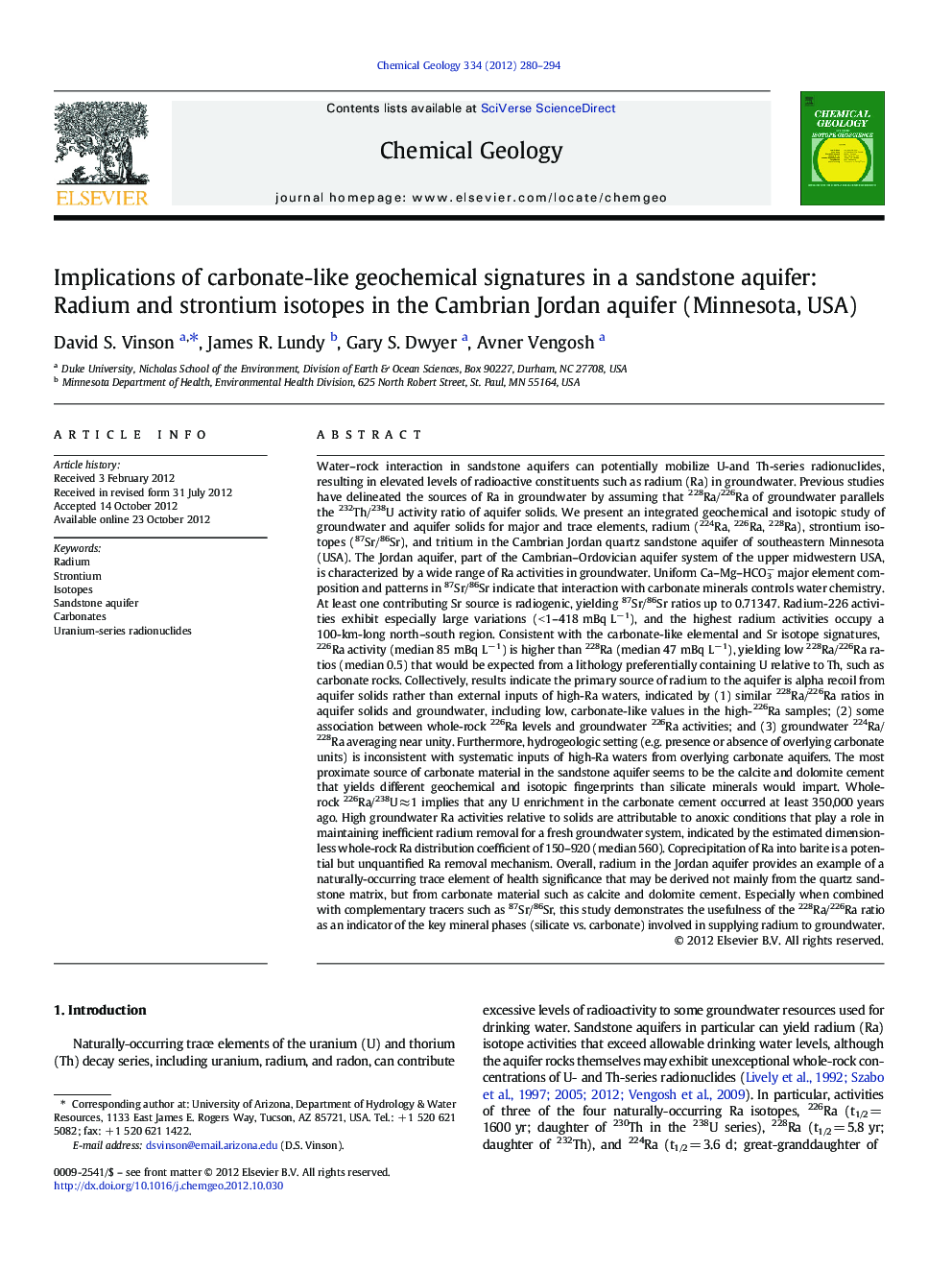| کد مقاله | کد نشریه | سال انتشار | مقاله انگلیسی | نسخه تمام متن |
|---|---|---|---|---|
| 4699188 | 1637633 | 2012 | 15 صفحه PDF | دانلود رایگان |

Water–rock interaction in sandstone aquifers can potentially mobilize U-and Th-series radionuclides, resulting in elevated levels of radioactive constituents such as radium (Ra) in groundwater. Previous studies have delineated the sources of Ra in groundwater by assuming that 228Ra/226Ra of groundwater parallels the 232Th/238U activity ratio of aquifer solids. We present an integrated geochemical and isotopic study of groundwater and aquifer solids for major and trace elements, radium (224Ra, 226Ra, 228Ra), strontium isotopes (87Sr/86Sr), and tritium in the Cambrian Jordan quartz sandstone aquifer of southeastern Minnesota (USA). The Jordan aquifer, part of the Cambrian–Ordovician aquifer system of the upper midwestern USA, is characterized by a wide range of Ra activities in groundwater. Uniform Ca–Mg–HCO3− major element composition and patterns in 87Sr/86Sr indicate that interaction with carbonate minerals controls water chemistry. At least one contributing Sr source is radiogenic, yielding 87Sr/86Sr ratios up to 0.71347. Radium-226 activities exhibit especially large variations (< 1–418 mBq L− 1), and the highest radium activities occupy a 100-km-long north–south region. Consistent with the carbonate-like elemental and Sr isotope signatures, 226Ra activity (median 85 mBq L− 1) is higher than 228Ra (median 47 mBq L− 1), yielding low 228Ra/226Ra ratios (median 0.5) that would be expected from a lithology preferentially containing U relative to Th, such as carbonate rocks. Collectively, results indicate the primary source of radium to the aquifer is alpha recoil from aquifer solids rather than external inputs of high-Ra waters, indicated by (1) similar 228Ra/226Ra ratios in aquifer solids and groundwater, including low, carbonate-like values in the high-226Ra samples; (2) some association between whole-rock 226Ra levels and groundwater 226Ra activities; and (3) groundwater 224Ra/228Ra averaging near unity. Furthermore, hydrogeologic setting (e.g. presence or absence of overlying carbonate units) is inconsistent with systematic inputs of high-Ra waters from overlying carbonate aquifers. The most proximate source of carbonate material in the sandstone aquifer seems to be the calcite and dolomite cement that yields different geochemical and isotopic fingerprints than silicate minerals would impart. Whole-rock 226Ra/238U ≈ 1 implies that any U enrichment in the carbonate cement occurred at least 350,000 years ago. High groundwater Ra activities relative to solids are attributable to anoxic conditions that play a role in maintaining inefficient radium removal for a fresh groundwater system, indicated by the estimated dimensionless whole-rock Ra distribution coefficient of 150–920 (median 560). Coprecipitation of Ra into barite is a potential but unquantified Ra removal mechanism. Overall, radium in the Jordan aquifer provides an example of a naturally-occurring trace element of health significance that may be derived not mainly from the quartz sandstone matrix, but from carbonate material such as calcite and dolomite cement. Especially when combined with complementary tracers such as 87Sr/86Sr, this study demonstrates the usefulness of the 228Ra/226Ra ratio as an indicator of the key mineral phases (silicate vs. carbonate) involved in supplying radium to groundwater.
► Elevated Ra levels are dominated by 226Ra (low 228Ra/226Ra ratio).
► Major ions, Ra, and Sr isotopes in the aquifer have carbonate-like signatures.
► Ra levels and 228Ra/226Ra are associated with solid-phase Ra and 228Ra/226Ra.
► Other influences on Ra levels are BaSO4 coprecipitation and redox conditions.
Journal: Chemical Geology - Volume 334, 12 December 2012, Pages 280–294